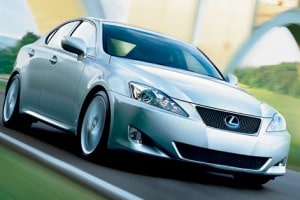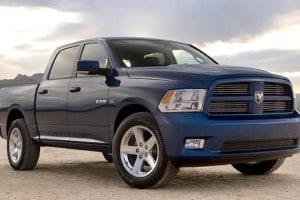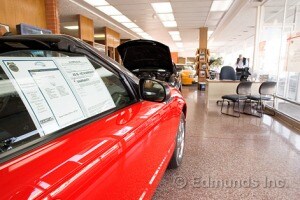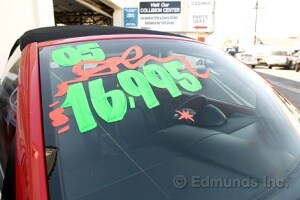Keep Your Left Foot Busy, Save a Few Bucks
 |
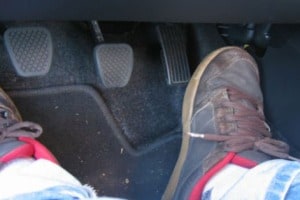
 |
When I was in high school, driving a stick-shift car was a badge of honor. But now, my friends wonder how I've made it this far without a car that does the work for me. Automatics are now the norm, and the manual transmission seems headed toward extinction. But here are a few practical reasons why stick-shift cars might deserve a second look.
Less Expensive
Cars with manual transmission will appeal to budget-conscious shoppers, because it costs an average of $800-$1,000 to upgrade to an automatic transmission. On the higher end, buyers interested in a Saturn Astra will have to pay an additional $1,325 to drive an automatic.
Also, the maintenance of a manual transmission offers some savings. According to Marc Uchiyama, assistant service manager at Honda of Santa Monica, the fluid for a manual transmission needs less frequent changes than on an automatic. And if a manual transmission ever breaks down, it's usually because the clutch needs to be replaced, a $1,200-$1,500 repair. Compare this to the $3,000 it costs to replace an automatic transmission and the savings is apparent.
Using a recent national gas price average of $4.10 per gallon, passing up an automatic could buy you about 195-244 gallons of gas. Put another way, if you bought a manual-transmission Nissan Versa over an automatic model, the savings would be enough to pay for six months of gas at that price.
Better Fuel Economy?
In the past, most manuals offered about a 5 percent improvement in fuel economy, the byproduct of the direct-drive transmission. But looking at current EPA estimates, it now appears that the numbers seem to be a wash. Why? While an automatic version of a car has a fuel economy advantage in the city, the manual version has the advantage on the highway. When the numbers are combined, they average out to be the same miles per gallon. But as the saying goes, the truth lies within. A person's method of shifting gears can significantly alter their fuel economy.
"Keeping the engine rpm low keeps [fuel] consumption low," said Dan Edmunds, director of vehicle testing at Edmunds.com. "Some folks will put the car in Neutral and coast up to a traffic signal to drop rpm as early as possible — a watered-down version of hybrid stop/start, if you will. Drivers of automatics will not do that because the whole point of an automatic is to simply slap it in 'D' and go about your business."
This freedom to choose how you drive is at the core of the reason why a manual transmission can get better gas mileage than an automatic. But because driving habits vary from one person to the next, not everyone will get the same results.
"An official EPA test consists of five specific driving 'cycles' designed to represent typical driving patterns," said Edmunds. "As a result, EPA fuel economy estimates can seem too conservative to those who drive in an efficient manner, and too optimistic to those with lead feet."
The electronics control how and when modern automatic-transmission shifts are optimized with the official EPA test cycles in mind, but — as with any set pattern — this may not always reflect how cars are driven in the real world. As a result, a driver of an automatic sometimes needs to manipulate the gas pedal to force a gearchange — thereby using more gas.
More Control, Less Distraction
Cars with manual transmissions also offer better control when driving because they have a faster shift response, and allow the driver to access extra power by downshifting on inclines. Through careful gear manipulation, a skilled driver of a manual transmission will have better traction in snowy and slippery conditions. A manual transmission also lets you downshift to use the engine to slow the car down, though this is generally not recommended because it accelerates the amount of wear on the clutch. Combine the faster shift response with the increased traction, and those few extra seconds could make all the difference in bad weather conditions.
In general, owners of manuals tend to be more attentive drivers: Changing gears requires a driver to pay attention to the engine and shift frequently, so the driver is less likely to zone out.
The Best of Both Worlds?
Many consumers may want the benefits of a manual but aren't willing to sacrifice the convenience of their automatic. This is where automanual transmissions come in. These cars do not have a clutch pedal and can function in both fully automatic and manually-shifted modes. For the most part, these cars are driven as automatics until the driver puts the transmission in manual mode.
The manually-shiftable automatic is the more common of the two automanual transmissions and is found on cars like the Honda Fit, Pontiac G8 and Mazda Mazda6. This type of transmission is essentially an automatic that lets the driver shift for himself. But in some of these vehicles, the car's computer will step in and make a gearchange if it's needed, such as upshifting when the engine hits redline. The chief complaint about many of these units is that there can be an annoying lag between when the driver calls for a gearchange and when it occurs.
The automated-clutch manual transmission has its origins in racing, and is primarily offered on high-end sport models such as the BMW M3 and the Mitsubishi Lancer Evolution MR. This transmission, which has a computer controlled clutch, offers lightning-fast shifts and allows the driver to concentrate on driving rather than clutch manipulation. Since these cars are geared toward performance, the shift quality in automatic mode is usually not as smooth as a traditional automatic.
As a testament to natural selection, and as gridlock becomes an ever-increasing part of life, our editors believe that automated-clutch manual transmissions are on their way to replacing the conventional manual transmission. But this technology has yet to be proven as far as long-term reliability, and it's usually more expensive. Manual transmission purists also argue that the lack of a clutch pedal reduces the driver's involvement and much of the enjoyment of driving a stick.
Uncertain Future
Despite the benefits, the number of cars with manual transmissions available in the United States is dwindling. And the fact that the newer automatics have caught up to, and in some cases surpassed, their manual counterparts in fuel-efficiency, explains the change.
"Automatic efficiency gains are the result of more efficient mechanical components, but really because of computerized shift control, throttle control and torque converter lockup," said Sage Marie, public relations manager for Honda.
The sales numbers for manuals paint a bleak picture for their future. Toyota has five models available with a manual transmission, but few are actually selling. Bill Kwong, spokesman for Toyota, says that manually shifted cars account for less than 2 percent of Toyota's total sales. He also attributes this wide margin to improvements in the quality of the automatic transmission, which has benefitted from compact designs and more gears — often up to six speeds.
"There's almost no difference when it comes to fuel economy," said Kwong. "The two overdrives in the Camry's automatic transmission really reduce the rpm," and save gas.
Final Thoughts
So who are these stick-shift cars best suited for?
There is no question that manual transmissions "resonate with customers who still enjoy the act of driving," said Marie.
Marie's comments hint at a larger issue. To many people, driving is just getting from Point A to Point B. The less they have to think about, the better. In recent years, consumers have been willing to pay more, get fewer miles per gallon and have less control of the vehicle — all for the sake of convenience. And though the advantages of a manual transmission aren't enough to cause a massive paradigm shift, today's gas prices and economy have more people scrambling to save every last dollar. It may seem daunting at first, but it's never too late to learn how to drive a manual transmission.
Less Expensive
Cars with manual transmission will appeal to budget-conscious shoppers, because it costs an average of $800-$1,000 to upgrade to an automatic transmission. On the higher end, buyers interested in a Saturn Astra will have to pay an additional $1,325 to drive an automatic.
Also, the maintenance of a manual transmission offers some savings. According to Marc Uchiyama, assistant service manager at Honda of Santa Monica, the fluid for a manual transmission needs less frequent changes than on an automatic. And if a manual transmission ever breaks down, it's usually because the clutch needs to be replaced, a $1,200-$1,500 repair. Compare this to the $3,000 it costs to replace an automatic transmission and the savings is apparent.
Using a recent national gas price average of $4.10 per gallon, passing up an automatic could buy you about 195-244 gallons of gas. Put another way, if you bought a manual-transmission Nissan Versa over an automatic model, the savings would be enough to pay for six months of gas at that price.
Better Fuel Economy?
In the past, most manuals offered about a 5 percent improvement in fuel economy, the byproduct of the direct-drive transmission. But looking at current EPA estimates, it now appears that the numbers seem to be a wash. Why? While an automatic version of a car has a fuel economy advantage in the city, the manual version has the advantage on the highway. When the numbers are combined, they average out to be the same miles per gallon. But as the saying goes, the truth lies within. A person's method of shifting gears can significantly alter their fuel economy.
"Keeping the engine rpm low keeps [fuel] consumption low," said Dan Edmunds, director of vehicle testing at Edmunds.com. "Some folks will put the car in Neutral and coast up to a traffic signal to drop rpm as early as possible — a watered-down version of hybrid stop/start, if you will. Drivers of automatics will not do that because the whole point of an automatic is to simply slap it in 'D' and go about your business."
This freedom to choose how you drive is at the core of the reason why a manual transmission can get better gas mileage than an automatic. But because driving habits vary from one person to the next, not everyone will get the same results.
"An official EPA test consists of five specific driving 'cycles' designed to represent typical driving patterns," said Edmunds. "As a result, EPA fuel economy estimates can seem too conservative to those who drive in an efficient manner, and too optimistic to those with lead feet."
The electronics control how and when modern automatic-transmission shifts are optimized with the official EPA test cycles in mind, but — as with any set pattern — this may not always reflect how cars are driven in the real world. As a result, a driver of an automatic sometimes needs to manipulate the gas pedal to force a gearchange — thereby using more gas.
More Control, Less Distraction
Cars with manual transmissions also offer better control when driving because they have a faster shift response, and allow the driver to access extra power by downshifting on inclines. Through careful gear manipulation, a skilled driver of a manual transmission will have better traction in snowy and slippery conditions. A manual transmission also lets you downshift to use the engine to slow the car down, though this is generally not recommended because it accelerates the amount of wear on the clutch. Combine the faster shift response with the increased traction, and those few extra seconds could make all the difference in bad weather conditions.
In general, owners of manuals tend to be more attentive drivers: Changing gears requires a driver to pay attention to the engine and shift frequently, so the driver is less likely to zone out.
The Best of Both Worlds?
Many consumers may want the benefits of a manual but aren't willing to sacrifice the convenience of their automatic. This is where automanual transmissions come in. These cars do not have a clutch pedal and can function in both fully automatic and manually-shifted modes. For the most part, these cars are driven as automatics until the driver puts the transmission in manual mode.
The manually-shiftable automatic is the more common of the two automanual transmissions and is found on cars like the Honda Fit, Pontiac G8 and Mazda Mazda6. This type of transmission is essentially an automatic that lets the driver shift for himself. But in some of these vehicles, the car's computer will step in and make a gearchange if it's needed, such as upshifting when the engine hits redline. The chief complaint about many of these units is that there can be an annoying lag between when the driver calls for a gearchange and when it occurs.
The automated-clutch manual transmission has its origins in racing, and is primarily offered on high-end sport models such as the BMW M3 and the Mitsubishi Lancer Evolution MR. This transmission, which has a computer controlled clutch, offers lightning-fast shifts and allows the driver to concentrate on driving rather than clutch manipulation. Since these cars are geared toward performance, the shift quality in automatic mode is usually not as smooth as a traditional automatic.
As a testament to natural selection, and as gridlock becomes an ever-increasing part of life, our editors believe that automated-clutch manual transmissions are on their way to replacing the conventional manual transmission. But this technology has yet to be proven as far as long-term reliability, and it's usually more expensive. Manual transmission purists also argue that the lack of a clutch pedal reduces the driver's involvement and much of the enjoyment of driving a stick.
Uncertain Future
Despite the benefits, the number of cars with manual transmissions available in the United States is dwindling. And the fact that the newer automatics have caught up to, and in some cases surpassed, their manual counterparts in fuel-efficiency, explains the change.
"Automatic efficiency gains are the result of more efficient mechanical components, but really because of computerized shift control, throttle control and torque converter lockup," said Sage Marie, public relations manager for Honda.
The sales numbers for manuals paint a bleak picture for their future. Toyota has five models available with a manual transmission, but few are actually selling. Bill Kwong, spokesman for Toyota, says that manually shifted cars account for less than 2 percent of Toyota's total sales. He also attributes this wide margin to improvements in the quality of the automatic transmission, which has benefitted from compact designs and more gears — often up to six speeds.
"There's almost no difference when it comes to fuel economy," said Kwong. "The two overdrives in the Camry's automatic transmission really reduce the rpm," and save gas.
Final Thoughts
So who are these stick-shift cars best suited for?
There is no question that manual transmissions "resonate with customers who still enjoy the act of driving," said Marie.
Marie's comments hint at a larger issue. To many people, driving is just getting from Point A to Point B. The less they have to think about, the better. In recent years, consumers have been willing to pay more, get fewer miles per gallon and have less control of the vehicle — all for the sake of convenience. And though the advantages of a manual transmission aren't enough to cause a massive paradigm shift, today's gas prices and economy have more people scrambling to save every last dollar. It may seem daunting at first, but it's never too late to learn how to drive a manual transmission.
